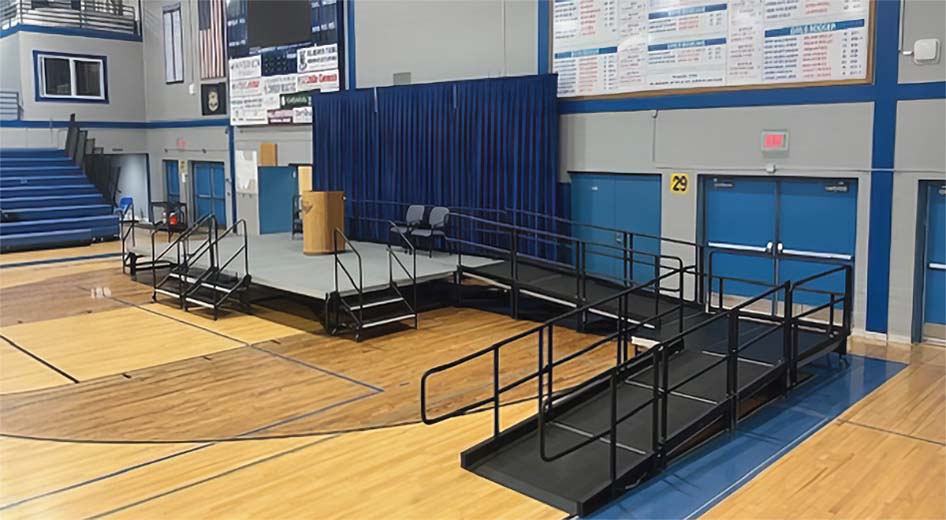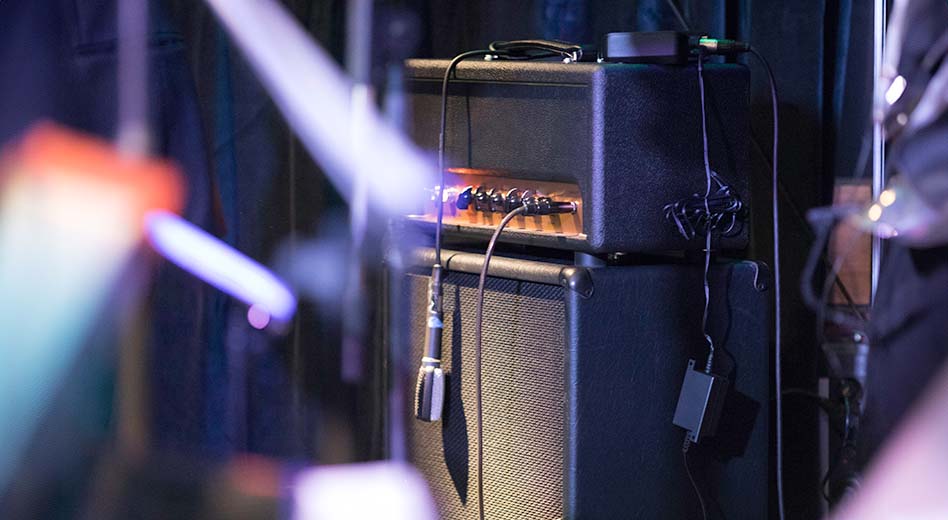
It is important to choose the right stage size, height, and weight capacity for your organization’s portable stage. There’s a lot more to think about than many realize, including the range of events you may be hosting, the potential size of productions or conferences, and whether there are unique requirements to safely manage different weight loads.
The following article breaks down the details about portable stage capacity, how different weight loads determine the type of equipment you should be using, and how to avoid common mistakes people make when choosing a stage.
What Is Portable Stage Capacity?
Stage capacity refers to the maximum weight a stage can safely support. Several factors should be considered when determining a stage’s capacity, including its design, materials, construction, and load distribution.

What Is a Load Rating?
A load rating refers to a stage’s load capacity, which is the specific evenly distributed weight a stage can support. Load capacity is measured in pounds per square foot (psf).
A stage’s load capacity or rating is determined by the manufacturer’s testing, which involves stress testing the stage until failure.
Different Types of Load Ratings for Portable Stages
The safety of a portable stage isn’t static. A portable stage’s capacity is determined by several factors, including the types of loads it is supporting.
Standard Uniform Load
This is the maximum weight a stage can support in pounds per square foot (psf) with evenly distributed weight across the stage’s entire surface.
Point Load
This refers to the maximum weight a stage can support at a single specific point without damage. Point load differs from standard uniform load, as it accounts for where weight is concentrated in a smaller portion of the stage.
To plan for different types of events, it is important to know both the uniform and point load capacities of a stage setup. Different performances could call for prop furniture one day and a grand piano the next. Your stage needs to be able to bear the weight of heavy objects in any given spot.
Dynamic Live Load
If point load is about being able to handle heavier loads in concentrated locations, dynamic live load measures your portable stage’s capacity to support weight that moves around. Performers don’t always remain in one place on stage. For performances with lots of physical activity, such as dance recitals or boxing matches, your stage must be sturdy enough not only to bear the weight but also to avoid swaying or losing side-to-side stability.

Factors to Consider When Calculating Stage Capacity
When considering the best options for your portable stage setup, you’ll be weighing factors such as cost, portability, and the size and location of your events. Storage considerations are also important, since portable stages won’t be used at every event. All of these matter, and will ultimately determine the setup you require.
Event Type and Activities
For concerts or dance performances, you should consider both the point load of any heavy equipment and the dynamic load for physical movement. For speaking events and conferences, point load may matter more, as your stage will need to handle the stationary weight of podiums, chairs, and other equipment. Specialized events like fashion shows or elaborate setups using multiple levels for band and choir performances will call for more robust support and careful load distribution.
Number of People and Equipment
Naturally, a stage’s size is a factor in determining the number of people it can accommodate at once. No matter how strong and robust the stage equipment is, there is a limit to how many people can comfortably sit or stand per square foot. Allocate 6-10 square feet per person, with extra space around the edge of the stage if there isn’t a full safety railing.
The overall strength of the stage is also important when considering how to support performers on a stage, since different stage manufacturers have different weight capacities.
Estimate 150–200 pounds per person when considering how many can share the stage at the same time with even distribution.
Beyond the overall weight distribution, consider whether this equipment will be concentrated in one spot, in which case you need to factor in point load. Meanwhile, consider the types of performances you will hold as you calculate the dynamic load.

Consider the following equipment and its weight:
- Lighting rigs
- Amplifiers and speakers
- Video/projection equipment
- Props or set pieces
- Musical instruments
Stage Dimensions and Design
The stage dimensions can determine what type of structural support is required to maintain the required uniform load. For instance, a smaller square-shaped stage may have sufficient support for its uniform capacity without needing extra support to handle dynamic and point loads. However, a long rectangular stage may need extra support to distribute the load capacity safely.
Consider whether the stage will need to accommodate elaborate sets, props, lighting rigs, or other elements of design and production. These could call for extra support.
Safety and Compliance
It is important to factor in safety and compliance before making any portable stage purchase decision. Whether an organization expects to use a stage for small community events or large music festivals, adhering to safety standards is vital.
Bear in mind the following safety considerations and regulatory standards:
- Building Codes and Regulatory Standards: Local building codes typically specify minimum load capacity and structural requirements. Building codes will include Occupational Safety and Health Administration (OSHA) and American National Standards Institute (ANSI) standards you need to comply with. In most cases, the minimum support weight is 150 pounds per square foot (psf).
- Structural Integrity and Load Capacity: After you purchase a stage, inspect your stage materials regularly for any signs of wear, loose connections, or other potential damage. You should conduct load testing before every event. Consider employing real-time load monitoring during events to prevent accidental overloads.
- Physical Safety: Install guardrails or barriers around the edges of your portable stage. This is particularly important for elevated sections of the stage. To prevent falls, use non-slip materials and install preventative systems like harnesses and safety nets where necessary.
- Electrical and Fire Safety: Follow electrical safety standards, which include grounding and circuit protection. Use waterproof covers for electrical equipment in outdoor settings. Be sure to keep fire extinguishers available.
- Access: To accommodate those with disabilities, make sure to follow all compliance requirements for entrance and exit ramps. This is also important for safe emergency evacuation.

How to Calculate Portable Stage Capacity
With the following calculations, always add a margin of safety to account for unanticipated loads or movement on stage. Adding 10–20% to the calculated load is standard practice. High-quality staging manufacturers will note the stage’s weight capacity. If you don’t see this information, you can calculate it yourself.
All MityLite portable stages have a weight capacity of 125 psf (pounds per square foot), or 4,000 pounds per section of staging.
To calculate a portable stage’s capacity, follow these steps.
- Determine the stage dimensions: Calculate the stage’s length, width, and height.
- Identify the material strength: The materials your stage is made from, like aluminum, steel, or wood, largely determine the stage’s load-bearing capacity.
- Calculate the total uniform load capacity: This is the maximum weight the stage can support per square foot under even distribution. Calculate this by multiplying the psf by the number of square feet. This is expressed as psf x sq ft.
- Identify point loads: To ensure the stage can support the load in a given spot, consider any heavy equipment and/or performers that will be concentrated in one area. Use the same formula as for uniform load capacity, based on the square footage of the specific areas where that weight is concentrated.
- Account for dynamic loads: To factor in the strength requirements for your portable stage, you must consider lateral forces. This can be complex to measure accurately because it involves taking the surface dimensions of the stage and the acceleration of lateral force. To make this easily measurable, dynamic load is typically treated as 10% to 20% of uniform load. This number should be added to the uniform load rating to determine the amount of weight your stage needs to support.
In all cases, factor in any specific local building codes, ordinances, and safety regulations and leave a margin of safety below the maximum weight ratings. If you are planning for complex setups or excessively heavy loads, consult with the stage manufacturer or a local structural engineer.
What Are the Typical Sizes and Heights of a Portable Stage?
While portable stages can come in many modular sizes and typically can be fastened together to form any stage size. MityLite portable stage panels range in size from 3′ x 6′ to 6′ x 8′, depending on the portable stage model.
Portable stage heights commonly range from 16″ to 40″, although the most popular requested stage heights are either 24″ and 16″ for most types of events. Some stages have adjustable leg sets so you can set the correct stage height for each event using the same legs.
As a general rule, the larger the event and the greater the number of guests, the higher the stage will need to be (to allow guests in the furthest back rows to see). So, a small event like a wedding might have a raised platform that’s just 6″-10″ high, while a standard speaker platform at a conference would be 16″ to 24″ high. Larger events and concerts will need a taller stage that is 24″ to 40″ high.

6 Common Mistakes in Buying Portable Staging
Organizations often make critical mistakes when choosing portable stages for their events. This can be a costly error if it means they have to completely replace an inadequate setup or turn down event opportunities for falling short of an event’s capacity requirements. In addition, mistakes can lead to safety issues, functionality problems, and even fines for ordinance violations.
The following are mistakes to avoid when choosing portable staging equipment.
1. Underestimating Weight Capacity
It’s easy to consider only a stage’s stated standard uniform load and underestimate real-world weight capacity requirements for live events. Failing to overestimate means a stage could be inadequate for point load weight for heavy stage equipment and dynamic load for active performances. Choose a stage with a high weight capacity, such as MityLite VersaRoll, Z-Stage, or Fold & Roll Stage, all of which have a 4,000-pound weight capacity per floor piece (125 pounds per square foot).
2. Overlooking Safety Requirements
Protective hardware like guardrails, anti-slip surfaces, stability reinforcement, clearly marked emergency exits, and proper anchoring are important. Overlooking the need for guardrails can lead to accidents, injuries, and lawsuits. Ignoring safety requirements can also lead to structural failure and penalties for failing to follow local requirements.
3. Failing to Consider Surface Material Options
Choosing the right stage surface is important for safety and enjoyment. For example, a carpeted surface can be helpful in controlling stage noise, while a hard, non-slip surface is important for dancers’ safety and optimal performance. Several MityLite stages are available with reversible surface options, allowing you to double the wear and event customization options. If you get a stage with reversible deck surfaces, you can choose two surfaces from several MityLite floorings: commercial-grade carpet, PolyTrac (a hard, non-slip ABS plastic surface), or TechStage (black textured fiberglass flooring).
4. Not Accounting for Various Event Types
It’s easy for an organization to make shortsighted planning decisions for the physical and structural requirements needed for a portable stage. Future events may require better visibility, accounting for audience interaction, safety features, and additional flexibility and reinforcement for more dynamic performances. Some events may require a stage with varying heights (such as may be needed for a choir or musical performance),
5. Misjudging Setup and Transport
Setting up and breaking down stage equipment requires a team of people who are capable of moving or carrying all stage parts into place. Some stages are easier to handle than others. All MityLite stages are either rolling or come with a cart. (Tip: For the easiest 1-person stage setup, choose the MityLite Fold & Roll Stage.) Consider the logistics of transporting the mobile stage throughout your facility, including accounting for sufficient clearance in doorways, elevators, and hallways. It’s easy to overlook these planning elements or underestimate the resources they will require.
6. Neglecting to Anticipate Technical Requirements
Platforms, supports, and rails are all important for a safe and sturdy stage setup. Some events also call for lighting, sound systems, curtains, projector screens, or other elements. This means event planners must consider electricity access when industrial-level power is required.

Buy Your Portable Stage Through MityLite
We hope this guide empowers you to determine the right features you will need in a portable stage at your property.
MityLite provides a complete range of portable stages made from high-quality materials with optimal strength-to-weight ratios. MityLite stages are sturdy, adaptable, customizable, and easy to transport and set up. Whatever the event requires, we have the stage design to match.

If you’ve got questions, that’s why we’re here! Send us an email at info@mityinc.com or give us a call at 800-909-8034.


